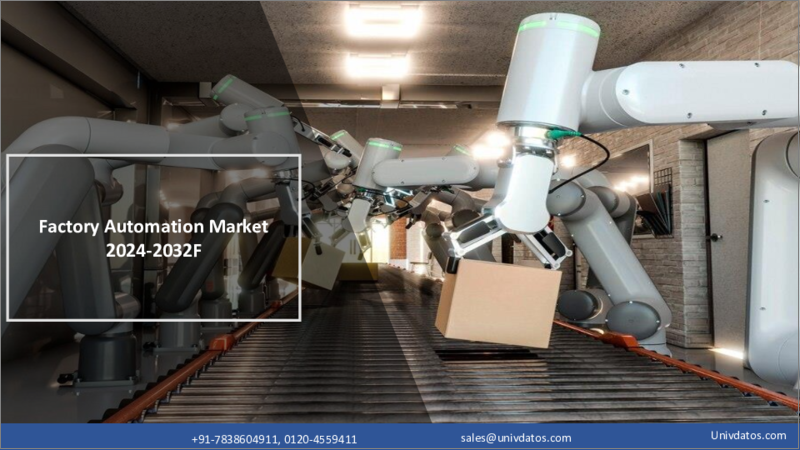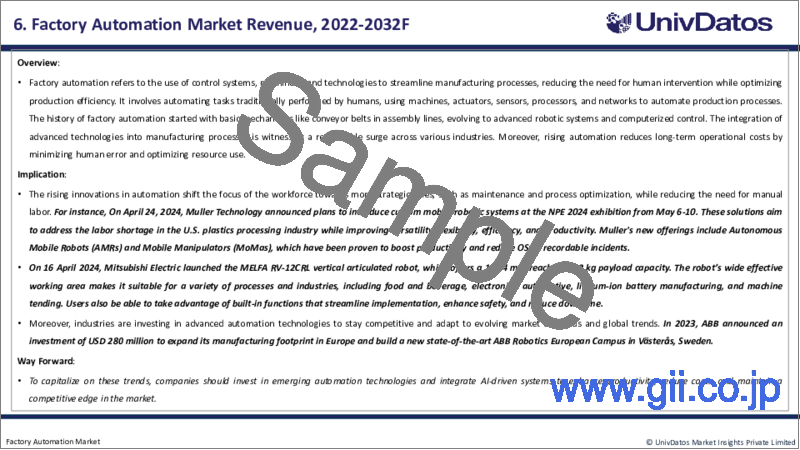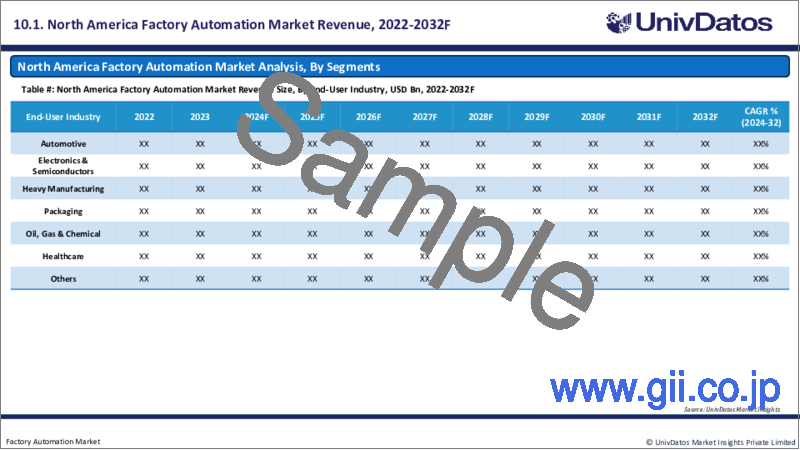|
|
市場調査レポート
商品コード
1496146
ファクトリーオートメーション市場:現状分析と予測(2024年~2032年)Factory Automation Market: Current Analysis and Forecast (2024-2032) |
||||||
カスタマイズ可能
|
|||||||
| ファクトリーオートメーション市場:現状分析と予測(2024年~2032年) |
|
出版日: 2024年05月01日
発行: UnivDatos Market Insights Pvt Ltd
ページ情報: 英文 142 Pages
納期: 即日から翌営業日
|
- 全表示
- 概要
- 目次
ファクトリーオートメーション市場は、AIやMLの普及と相まって、より良い効率性とより高い生産性への需要の高まりにより、約8.60%の力強いCAGRで成長すると予測されます。ファクトリーオートメーション、製造プロセスへの先端技術の統合は、様々な産業で顕著な急増を目の当たりにしています。この変革的なシフトは、工場の運営方法を再構築する多数の要因によって推進されています。効率や生産性の向上から、労働力不足への対応や製品品質の改善まで、ファクトリーオートメーションは製造業の状況を一変させるものとして台頭しています。さらに、製造業者は、今日の競争の激しい世界市場において、コストを最小限に抑えながら、オペレーションを最適化し、生産量を最大化する必要に常に迫られています。自動化されたシステムは、ダウンタイムを最小限に抑えながら24時間稼働することができ、その結果、生産率が向上し、設備全体の効率(OEE)が改善されます。例えば、国際ロボット連盟(IFR)の報告書によると、産業用ロボットを導入することで、さまざまな産業で生産性が平均15~30%向上しています。さらに、特に新興経済諸国では、労働力の高齢化や人口動向の変化により、多くの産業が熟練労働者の不足に直面しています。オートメーションテクノロジーは、反復的、肉体的に厳しい、あるいは危険な作業を代行することで、人間の労働力への依存を減らし、この課題を軽減することができます。試算によると、先進国では人件費が製造コスト全体の最大25%を占めており、競争力を維持するために自動化の導入が推進されています。さらに、自動化されたシステムは高精度で一貫性があるため、人為的ミスのリスクが減り、安定した製品品質が保証されます。自動車、エレクトロニクス、医薬品など、品質管理が重要な産業では、厳しい品質基準を満たすために自動化の導入が進んでいます。例えば、製造技術協会(AMT)の調査によると、製造業者の70%が自動化ソリューションを導入する主な要因として製品品質の向上を挙げています。最後に、製造プロセスのデジタル化と相互接続を促進したインダストリー4.0革命は、オートメーション技術の採用を加速させました。IoT、サイバーフィジカルシステム、クラウドコンピューティングによって実現されたスマート工場は、自動化を活用してリアルタイムのモニタリング、データ主導の意思決定、柔軟な生産能力を実現しています。
コンポーネントに基づき、市場は産業用ロボット、マシンビジョン、プロセスアナライザー、フィールド機器、ヒューマンマシンインターフェース、産業用PC、産業用センサー、産業用3Dプリンターに区分されます。産業用ロボットは最も広く採用されており、需要も高いです。産業用ロボットは、現代のファクトリーオートメーションのバックボーンとして確固たる地位を築いています。これらの汎用性の高い機械は、比類のない精度、スピード、一貫性で膨大なタスクを実行することができます。組立、溶接からマテリアルハンドリング、包装に至るまで、産業用ロボットは自動車、エレクトロニクス、消費財を含むさまざまな産業で不可欠な資産となっています。産業用ロボットの優位性は、生産性と効率を向上させる可能性に起因しています。産業用ロボットは、オートメーションアプリケーションにおいて、コストを下げながら生産性を向上させ、高品質な製品を生み出すのに役立っています。さらに、技術の進歩も産業用ロボットの採用に大きな役割を果たしています。5Gワイヤレス技術の開発とインダストリー4.0の採用が、ファクトリーオートメーションソリューションの需要を牽引しています。産業用モノのインターネット(IIoT)は、効率的でコスト効率が高く、応答性の高いシステムアーキテクチャの開発を促進するため、オートメーション技術にとって不可欠です。このような要因が環境を促進し、様々な産業におけるファクトリーオートメーション向け産業用ロボットの採用を後押ししています。
ソリューションは、分散制御システム(DCS)、プログラマブルロジックコントローラ(PLC)、監視制御・データ収集(SCADA)、製造実行システム(MES)、企業資源計画(ERP)、その他に分類されます。SCADAシステムは、様々な市場においてファクトリーオートメーションに最も広く採用されているソリューションです。主に、リアルタイムの監視と制御を提供する機能がその原動力となっています。SCADAシステムは、ソフトウェアとハードウェアを組み合わせることで、ローカルまたはリモートで工場のプロセスを制御・監視することができます。この機能は、タイムリーで正確な情報が効率的なオペレーションに不可欠なファクトリーオートメーションにおいて極めて重要です。さらに、SCADAシステムは工場オペレーションの効率を高める。インテリジェントな製造インフラを使用することで、製造やマテリアルハンドリングの迅速なオペレーションを可能にします。産業界は生産性を高め、人件費を削減するためにSCADAシステムを導入しています。このような開発は、とりわけ有利な環境を作り出し、SCADAのファクトリーオートメーション需要に影響を与えています。
エンドユーザー産業に基づき、市場は自動車、エレクトロニクス・半導体、重工業、包装、石油・ガス・化学、ヘルスケア、その他に区分されます。自動車産業はファクトリーオートメーションの主要なエンドユーザー分野として確固たる地位を築いています。自動車産業におけるファクトリーオートメーションは、生産効率の向上につながります。自動化されたシステムは、疲労することなく連続的に作業することができ、安定した品質と高い生産性を保証します。これは、大量生産が求められる自動車産業では特に重要です。さらに、ファクトリーオートメーションは、自動車産業における大幅なコスト削減にもつながります。プロセスを自動化することで、企業は人件費を削減し、効率を高めて生産コストを下げることができます。これらの進歩により、ファクトリーオートメーション産業は、自動車産業からの需要増加により、繁栄する好環境を作り出しています。
ファクトリーオートメーションの市場導入に関する理解を深めるため、市場は北米(米国、カナダ、その他北米地域)、欧州(ドイツ、英国、フランス、スペイン、イタリア、その他欧州地域)、アジア太平洋地域(中国、日本、インド、韓国、その他アジア太平洋地域)、世界のその他の地域における世界のプレゼンスに基づいて分析されています。アジア太平洋地域は、中国、日本、台湾、韓国、インドなどの国々がファクトリーオートメーション市場の支配的勢力として急速に台頭しており、予測期間中に大幅な成長が見込まれています。同地域の工業化の急速な進展が主な要因です。アジア太平洋地域では、消費財に対する需要の高まりや多国籍企業の存在感の高まりを背景に、工業化が急速に進んでいます。この動向は、効率的で自動化された製造プロセスへのニーズに拍車をかけ、ファクトリーオートメーションソリューションの採用を後押ししています。さらに、日本や中国などのアジア太平洋地域の国々では、高齢化による労働力不足と、人件費の高騰という課題に直面しています。ファクトリーオートメーションは、手作業への依存を減らし、業務効率を向上させることで、これらの課題に対処します。さらに、ファクトリーオートメーションを採用することで、アジア太平洋地域の製造業者は世界市場で競争力を得ることができます。自動化されたプロセスにより、高品質な製品をより低コストで生産することが可能になり、世界中の消費者にとってより魅力的な製品を提供できるようになります。このような要因が、アジア太平洋地域におけるファクトリーオートメーションの高成長につながるシナリオを生み出しています。
目次
第1章 市場イントロダクション
- 市場の定義
- 主な目標
- ステークホルダー
- 制限事項
第2章 調査手法または前提条件
- 調査プロセス
- 調査手法
- 回答者プロファイル
第3章 市場要約
第4章 エグゼクティブサマリー
第5章 COVID-19がファクトリーオートメーション市場に与える影響
第6章 ファクトリーオートメーション市場収益、2022-2032年
第7章 コンポーネント別の市場分析
- 産業用ロボット
- マシンビジョン
- プロセスアナライザー
- フィールド機器
- ヒューマンマシンインターフェース
- 産業用PC
- 産業用センサー
- 産業用3Dプリンター
第8章 ソリューション別の市場分析
- 分散制御システム(DCS)
- プログラマブルロジックコントローラ(PLC)
- 監視制御・データ収集(SCADA)
- 製造実行システム(MES)
- エンタープライズリソースプランニング(ERP)
- その他
第9章 エンドユーザー産業別の市場分析
- 自動車
- エレクトロニクス・半導体
- 重工業
- 包装
- 石油・ガス・化学
- ヘルスケア
- その他
第10章 地域別の市場分析
- 北米
- 米国
- カナダ
- その他北米地域
- 欧州
- ドイツ
- 英国
- フランス
- イタリア
- その他欧州地域
- アジア太平洋地域
- 中国
- インド
- 日本
- 韓国
- その他アジア太平洋地域
- 世界のその他の地域
第11章 ファクトリーオートメーション市場力学
- 市場促進要因
- 市場の課題
- 影響分析
第12章 ファクトリーオートメーション市場機会
第13章 ファクトリーオートメーション市場動向
第14章 需要側と供給側の分析
- 需要側分析
- 供給側分析
第15章 バリューチェーン分析
第16章 競合シナリオ
- 競合情勢
- ポーターのファイブフォース分析
第17章 企業プロファイル
- ABB
- Emerson Electric Co.
- Siemens
- Schneider Electric
- Mitsubishi Electric Corporation
- Yokogawa Electric Corporation
- Honeywell International Inc.
- Rockwell Automation
- General Electric Company
- Robert Bosch GmbH
第18章 免責事項
Factory automation refers to the use of control systems, machinery, and technologies to streamline manufacturing processes, reducing the need for human intervention while optimizing production efficiency. It involves automating tasks traditionally performed by humans, using machines, actuators, sensors, processors, and networks to automate production processes. The history of factory automation started with basic mechanisms like conveyor belts in assembly lines, evolving to advanced robotic systems and computerized control.
The Factory Automation Market is expected to grow at a strong CAGR of around 8.60% owing to the increased demand for better efficiency and higher productivity, coupled with widespread adoption of AI and ML. Factory automation, the integration of advanced technologies into manufacturing processes, is witnessing a remarkable surge across various industries. This transformative shift is being driven by a multitude of factors that are reshaping the way factories operate. From enhancing efficiency and productivity to addressing labor shortages and improving product quality, factory automation is emerging as a game-changer in the manufacturing landscape. Furthermore, manufacturers are under constant pressure to optimize their operations and maximize output while minimizing costs in today's highly competitive global market. Automated systems can operate around the clock with minimal downtime, resulting in higher production rates and improved overall equipment effectiveness (OEE). For instance, according to a report by the International Federation of Robotics (IFR), implementing industrial robots has led to an average increase in productivity of 15-30% in various industries. Additionally, many industries, particularly in developed economies, are facing a shortage of skilled labor due to an aging workforce and shifting demographic trends. Automation technologies can alleviate this challenge by taking over repetitive, physically demanding, or hazardous tasks, reducing the reliance on human labor. According to estimates, labor costs account for up to 25% of total manufacturing costs in developed countries, driving the adoption of automation to remain competitive. Moreover, automated systems are highly precise and consistent, reducing the risk of human error and ensuring consistent product quality. Industries such as automotive, electronics, and pharmaceuticals, where quality control is critical, are increasingly adopting automation to meet stringent quality standards. For instance, according to a survey by the Association for Manufacturing Technology (AMT), 70% of manufacturers cited improved product quality as a key driver for implementing automation solutions. Lastly, the Industry 4.0 revolution, which promoted the digitization and interconnectivity of manufacturing processes, has accelerated the adoption of automation technologies. Smart factories, enabled by IoT, cyber-physical systems, and cloud computing, leverage automation to achieve real-time monitoring, data-driven decision-making, and flexible production capabilities.
Based on the component, the market is segmented into industrial robots, machine vision, process analyzers, field instruments, human-machine interfaces, industrial PCs, industrial sensors, and industrial 3D printers. Industrial robots are the most widely adopted and are in high demand. Industrial robots have firmly established themselves as the backbone of modern factory automation. These highly versatile machines can perform a vast array of tasks with unparalleled precision, speed, and consistency. From assembly and welding to material handling and packaging, industrial robots have become indispensable assets across various industries, including automotive, electronics, and consumer goods. The dominance of industrial robots can be attributed to their potential to increase productivity and efficiency. Industrial robots aid in improving productivity while lowering costs and generating high-quality goods in automation applications. Furthermore, technological advancements have played a significant role in the adoption of industrial robots. The development of 5G wireless technology and the adoption of Industry 4.0 have driven the demand for factory automation solutions. The Industrial Internet of Things (IIoT) is essential to automation technology as it facilitates the development of efficient, cost-efficient, and responsive system architectures. Factors such as these foster a conducive environment and support the growth in adopting industrial robots for factory automation across various industries.
Based on the solution, the market is segmented into a distributed control system (DCS), programmable logic controller (PLC), supervisory control and data acquisition (SCADA), manufacturing execution system (MES), enterprise resource planning (ERP), and others. The SCADA system has been identified as the most widely adopted solution for factory automation across various markets. Primarily driven by its capability to provide real-time monitoring and control. They combine software and hardware elements that allow organizations to control and monitor factory processes locally or remotely. This capability is crucial in factory automation, where timely and accurate information is essential for efficient operations. Furthermore, SCADA systems enhance the efficiency of factory operations. They enable swift operations of manufacturing and material handling with the use of intelligent manufacturing infrastructure. Industries are deploying SCADA systems to increase productivity and reduce labor costs. These developments among others are creating a favorable environment, influencing the demand for SCADA for factory automation.
Based on end-user industry, the market is segmented into automotive, electronics & semiconductor, heavy manufacturing, packaging, oil, gas, & chemical, healthcare, and others. The automotive industry has firmly established itself as a major end-user segment for factory automation. Factory automation in the automotive industry leads to increased production efficiency. Automated systems can work continuously without fatigue, ensuring consistent quality and high productivity. This is particularly important in the automotive industry, where high production volumes are required. Furthermore, factory automation leads to significant cost reductions in the automotive industry. By automating processes, companies can reduce labor costs and increase efficiency, lowering production costs. These advancements, among others, are creating a favorable environment where the factory automation industry is thriving, with the increased demand from the automotive industry.
For a better understanding of the market adoption of Factory Automation, the market is analyzed based on its worldwide presence in countries such as North America (The U.S., Canada, and the Rest of North America), Europe (Germany, The U.K., France, Spain, Italy, Rest of Europe), Asia-Pacific (China, Japan, India, South Korea, Rest of Asia-Pacific), Rest of World. Asia Pacific is anticipated to experience substantial growth during the predicted timeframe, where countries like China, Japan, Taiwan, South Korea, and India are rapidly emerging as a dominant force in the factory automation market. Primarily driven by the surging industrialization of the region. The Asia Pacific region is experiencing a surge in industrialization, driven by the growing demand for consumer goods and the increasing presence of multinational corporations. This trend has fueled the need for efficient and automated manufacturing processes, propelling the adoption of factory automation solutions. Furthermore, several countries in the Asia Pacific region, such as Japan and China, are facing labor shortages due to aging populations simultaneously with the challenges of rising labor costs. Factory automation counters both these challenges by reducing the reliance on manual labor and increasing operational efficiency. Moreover, embracing factory automation enables manufacturers in the Asia Pacific region to gain a competitive edge in the global market. Automated processes will allow them to produce high-quality products at lower costs, making their offerings more attractive to consumers worldwide. Factors such as these have created a scenario that has led to the high growth of factory automation in the Asia Pacific region.
Some of the major players operating in the market include ABB; Emerson Electric Co.; Siemens; Schneider Electric; Mitsubishi Electric Corporation; Yokogawa Electric Corporation; Honeywell International Inc.; Rockwell Automation; General Electric Company; and Robert Bosch GmbH.
TABLE OF CONTENTS
1.MARKET INTRODUCTION
- 1.1. Market Definitions
- 1.2. Main Objective
- 1.3. Stakeholders
- 1.4. Limitation
2.RESEARCH METHODOLOGY OR ASSUMPTION
- 2.1. Research Process of the Factory Automation Market
- 2.2. Research Methodology of the Factory Automation Market
- 2.3. Respondent Profile
3.MARKET SYNOPSIS
4.EXECUTIVE SUMMARY
5.IMPACT OF COVID-19 ON THE FACTORY AUTOMATION MARKET
6.FACTORY AUTOMATION MARKET REVENUE (USD BN), 2022-2032F.
7.MARKET INSIGHTS BY COMPONENT
- 7.1. Industrial Robots
- 7.2. Machine Vision
- 7.3. Process Analyzer
- 7.4. Field Instruments
- 7.5. Human Machine Interface
- 7.6. Industrial PC
- 7.7. Industrial Sensors
- 7.8. Industrial 3D Printers
8.MARKET INSIGHTS BY SOLUTION
- 8.1. Distributed Control System (DCS)
- 8.2. Programmable Logic Controller (PLC)
- 8.3. Supervisory Control and Data Acquisition (SCADA)
- 8.4. Manufacturing Execution System (MES)
- 8.5. Enterprise Resource Planning (ERP)
- 8.6. Others
9.MARKET INSIGHTS BY END-USER INDUSTRY
- 9.1. Automotive
- 9.2. Electronics & Semiconductors
- 9.3. Heavy Manufacturing
- 9.4. Packaging
- 9.5. Oil, Gas & Chemical
- 9.6. Healthcare
- 9.7. Others
10.MARKET INSIGHTS BY REGION
- 10.1. North America
- 10.1.1. The U.S.
- 10.1.2. Canada
- 10.1.3. Rest of North America
- 10.2. Europe
- 10.2.1. Germany
- 10.2.2. The UK
- 10.2.3. France
- 10.2.4. Italy
- 10.2.5. Rest of Europe
- 10.3. Asia-Pacific
- 10.3.1. China
- 10.3.2. India
- 10.3.3. Japan
- 10.3.4. South Korea
- 10.3.5. Rest of Asia-Pacific
- 10.4. Rest of the World
11.FACTORY AUTOMATION MARKET DYNAMICS
- 11.1. Market Drivers
- 11.2. Market Challenges
- 11.3. Impact Analysis
12.FACTORY AUTOMATION MARKET OPPORTUNITIES
13.FACTORY AUTOMATION MARKET TRENDS
14.DEMAND AND SUPPLY-SIDE ANALYSIS
- 14.1. Demand Side Analysis
- 14.2. Supply Side Analysis
15.VALUE CHAIN ANALYSIS
16.COMPETITIVE SCENARIO
- 16.1. Competitive Landscape
- 16.1.1. Porters Five Forces Analysis
17.COMPANY PROFILED
- 17.1. ABB
- 17.2. Emerson Electric Co.
- 17.3. Siemens
- 17.4. Schneider Electric
- 17.5. Mitsubishi Electric Corporation
- 17.6. Yokogawa Electric Corporation
- 17.7. Honeywell International Inc.
- 17.8. Rockwell Automation
- 17.9. General Electric Company
- 17.10. Robert Bosch GmbH






